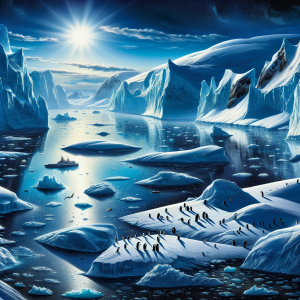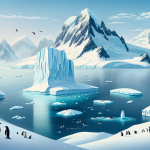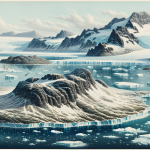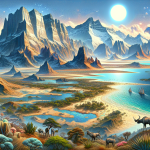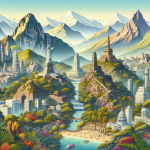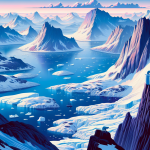Antarctica: The Last Great Wilderness
Antarctica, the enigmatic and remote landmass at the southernmost part of our planet, has long fascinated adventurers, scientists, and travelers alike. With its vast, icy landscapes, unique wildlife, and extreme weather conditions, it offers an unparalleled experience for those daring enough to explore its frozen expanse. The continent, roughly twice the size of Australia, is a natural wonder and a scientific treasure trove. Its pristine environment and complex ecosystems provide invaluable insights into our planet’s past, present, and future. In this article, we will delve into the allure of Antarctica, exploring its incredible landscapes, rich biodiversity, and the myriad ways you can experience this last great wilderness. Whether you’re planning an expedition or simply dreaming of one, read on to uncover the mysteries and marvels of Antarctica.
The Allure of Antarctica
Pristine Landscapes
Antarctica’s landscapes are like no other on Earth. The continent is dominated by its ice sheet, which contains about 60% of the world’s fresh water. The ice, often several miles thick, creates an otherworldly terrain of glaciers, icebergs, and ice shelves. These formations constantly shift and change, sculpted by the relentless forces of wind and water. The Ross Ice Shelf, for instance, is one of the largest floating ice platforms on the planet. Visitors often describe the surreal beauty of these icy vistas, where the light plays off the ice to create a dazzling array of colors and patterns.
Unique Wildlife
Despite its harsh conditions, Antarctica is home to a surprising variety of wildlife. The continent and its surrounding waters support a range of species that have adapted to the extreme environment. Penguins are perhaps the most iconic Antarctic residents, with species like the Emperor Penguin and the Adélie Penguin being particularly well-known. Seals, such as the Weddell Seal and the Leopard Seal, are also common sights. In the Southern Ocean, you can find numerous whale species, including the majestic Blue Whale and the Orca. Birdlife is abundant too, with albatrosses and petrels often seen soaring above the waves.
Scientific Research
Antarctica is a hub for scientific research, with dozens of international research stations dotted around the continent. Scientists study a wide range of topics, from climate change and glaciology to biology and astronomy. The continent’s ice cores, which can be drilled to extract samples, provide a historical record of Earth’s climate going back hundreds of thousands of years. Understanding these records helps scientists predict future climate trends. Additionally, Antarctica’s remote location and clear skies make it an excellent place for astronomical observations.
Planning Your Antarctic Adventure
When to Visit
The best time to visit Antarctica is during the austral summer, which runs from November to March. During this period, temperatures are relatively mild, ranging from -2°C to 8°C (28°F to 46°F). The extended daylight hours—sometimes up to 24 hours of daylight—also make it easier to spot wildlife and explore the landscape. However, this is also the peak tourist season, so it’s advisable to book your trip well in advance.
How to Get There
Reaching Antarctica requires careful planning and often involves multiple modes of transportation. Most travelers start their journey in South America, with Ushuaia in Argentina being a popular departure point. From there, you can take a cruise or a flight to the Antarctic Peninsula. Cruises vary in length and amenities, ranging from basic expedition vessels to luxury liners. Some tours also offer the option to fly to King George Island, bypassing the often rough seas of the Drake Passage.
What to Pack
Packing for Antarctica is all about preparation and layering. Essential items include a high-quality, waterproof and windproof outer layer, thermal base layers, warm mid-layers, and sturdy, waterproof boots. Accessories like gloves, hats, and scarves are also crucial for keeping warm. Don’t forget sunscreen and sunglasses, as the sun’s rays can be intense, reflecting off the ice and snow.
Exploring Antarctica
Popular Destinations
- Antarctic Peninsula: This is the most accessible part of Antarctica and offers stunning landscapes, abundant wildlife, and historic sites like research stations and whaling stations.
- South Shetland Islands: These islands are known for their dramatic landscapes and large penguin colonies. Deception Island, with its active volcano, is a particularly intriguing destination.
- Ross Sea: Located on the opposite side of the continent from the Peninsula, the Ross Sea is often referred to as the “Last Ocean” due to its pristine condition and rich biodiversity.
Activities
- Wildlife Watching: One of the main draws of Antarctica is its incredible wildlife. Expeditions often include opportunities to see penguins, seals, and whales up close.
- Ice Hiking and Mountaineering: For the more adventurous, many tours offer guided hikes and mountaineering expeditions. These activities allow you to explore the continent’s stunning glaciers and ice formations.
- Kayaking and Zodiac Cruising: Exploring the icy waters by kayak or Zodiac boat offers a unique perspective on the landscape and wildlife.
Environmental Considerations
Leave No Trace
Antarctica is one of the last places on Earth that remains largely untouched by human activity. To preserve its pristine environment, it’s crucial to follow the principles of Leave No Trace. This means minimizing your impact by sticking to designated paths, not disturbing wildlife, and taking all waste back with you.
Responsible Tourism
Many tour operators are committed to responsible tourism practices. Look for companies that are members of the International Association of Antarctica Tour Operators (IAATO), which promotes safe and environmentally responsible travel to Antarctica.
Conclusion
Antarctica is a destination like no other. Its stunning landscapes, unique wildlife, and scientific significance make it a truly remarkable place to visit. Whether you’re an adventurer, a nature lover, or a science enthusiast, the White Continent offers experiences that you won’t find anywhere else. By planning carefully and traveling responsibly, you can help ensure that this last great wilderness remains pristine for future generations to enjoy. So, if you’ve ever dreamed of exploring the ends of the Earth, consider embarking on an Antarctic adventure. It’s a journey that promises to be as enlightening as it is awe-inspiring.
